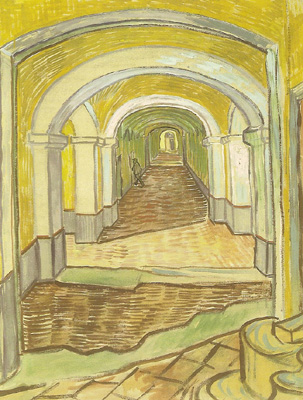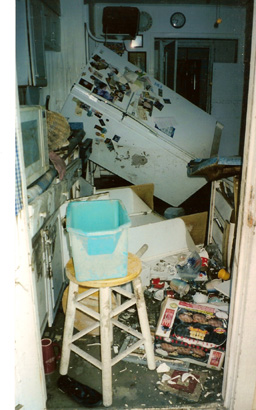Deluge(d)
Mme NOLA is in town. M NOLA was to come too - this visit to Ms NOLA was planned ages ago - but as he was engaged in finally getting back to work, he thought it best to remain at home. Home, at the moment, is an apartment in the French Quarter; I believe that he is moving in this evening. There is not much to move. The contents of chez NOLA were pretty much obliterated by the waters of Lake Pontchartrain. Every piece of furniture save one - every piece including the upright piano - was tipped over by the flood. The other day, I saw photographs that were hard to believe. Flooding, yes, ruination, yes. One grasped that. One hadn't, in advance, grasped the filth and the mold.
But Mme NOLA is here for the week, and we had to have a tour of the museums. On her last visit, Mme NOLA and I were alone, but this time Ms NOLA got the day off to join us. We met at the Barnes & Noble near the 86th Street stop of the Lex. Arriving all at the same moment, we headed out again, through sprinkling rain, to the Guggenheim, where the show, Russia!, occupies the entire spiral. Our plan was to head to the Met for lunch afterward, and then to see the exhibitions of medieval treasures from Prague and of "Spiritualist" photography.
The show at the Guggenheim was a miscellany of Russian art from the fifteenth century (or perhaps earlier) to the day before yesterday. All of it was very competent. There were a few awkward pieces that reflected the unsure accommodation of East and West, but these were always arresting in their perplexity. There was a great deal of frankly derivative work - derivative of Western styles not much in favor today outside the Dahesh Museum. There was a very jolly bust of Catherine the Great. Among the nineteenth-century works were several beautiful oil paintings of twilights and moonrises that I should have called "Luminist" if only Google would support the claim; since it doesn't, I'll say that these paintings seemed to address the same yearning as does the work of our Hudson River School. Around 1900, things begin to get interesting in a new way; I saw quite a few things that would be at home at the Neue Galerie (which I have yet to revisit). Then the first bursts of native greatness: Chagall, Kandinsky, Malevich. The show ends with a bunch of installations that demonstrate that Muscovites are no better than New Yorkers at working out the godawful confusion of flat-panel art and sculpture. And no worse.
My knees can handle the climb, but the descent is bruising. We took the elevator downstairs. I thought briefly of buying the catalgue, so that I could write more learnedly about Russia! But that seemed pretty fake. If I go back - and I probably won't - I'll take notes. There is one really beautiful Portrait of the Artist's Son from the early nineteenth century, and I'm sorry that I didn't scribble down the father's name.
After lunch in the other museum, we took the magic elevator up to the Old Master galleries. This elevator is seldom in use, but it cuts hours from getting from the cafeteria in the basement to the Tisch Galleries on the second floor. You pop out amid Italian Renaissance paintings, proceed through a German gallery, and then take the Netherlandish enfilade to what I call the Lavoisier Room. Proceeding through the Tiepolo gallery takes you to the top of the grand staircase, where you turn toward the south - oh, I'm getting tired just thinking about it. I marched briskly along the path just described while Ms NOLA and her mother complimented themselves upon having someone who really knows the museum to lead them through it - "And even if you don't know where you're going, you look like you do."
Just how true this jest was would soon be demonstrated. For I had no idea where we were going. I had no idea that it was there to go to. Later, I would remember an article in the Times, and a preview-invitation-sized envelope that I hadn't opened. But at one end of the Lavoisier Room stood two nice ladies by a little table that read "Members Only." I caught that first. Then, Vincent van Gogh: The Drawings. Well, this was a show that my guests would certainly want to see. I whipped out my membership card and asked if it would get me in. It would get us all in. We spent the next hour in a state of Deep Treat.
I am not a fan of van Gogh. I tried very hard, at the van Gogh Museum in Amsterdam, to like his paintings, but they seemed increasingly fantastic and - suitable for children's books. Their excessiveness oppressed instead of exciting me. Since Kathleen loves van Gogh, I always feel a little left out by this painter. But left out I shall feel no more. I will admire any number of paintings if I can bear in mind the extraordinary works on paper that I saw the other day. From the very beginning - A Marsh (1881 ) - to the very end - Corridor in the Asylum (1889-1890). All the extravagance of the painter's colors reappeared to me, in the drawings, in a form much more appealing as an extravagance of beautifully organized detail. I am still shaking a little from having seen Rock and Ruins, Montmajour (1888). That rock!

Many of the drawings are studies for the famous paintings. Several are "souvenirs," drawn simply to inform a correspondent of the colors of the painting, with bleu or chrome written in between the lines of a given area. But the most striking compare-and-contrast occurred for me when I came upon the multimedia Harvest in Provence hanging next to its version in oils (both works 1888). The painting, Harvest in Provence, is a star at the van Gogh Museum, and I remember studying it hard, trying to identify what it was that kept me from liking a picture so colorful and yet so ordered. In the end, I came away thinking that it was too simple, and while you may dismiss me as a barbarian, I found that the counterpart, drawn in everything from reed pen to wax crayon, vindicated my judgment. This is the not-too-simple version of the picture, and one has only to look at the sky to see what I'm talking about. The painting's sky is an uninflected uniform French blue. The drawing's sky is hardly blue at all, so busy are the cumulus clouds drifting across it. The vitality of penned scribbles makes the profusion of brush strokes look tired. In the drawing, we're shown what's really there, not the color of what's really there.
This show will close at the end of the year (literally), and then reopen in Amsterdam. It is the van Gogh show, so get yourself to it on one continent or the other. Let's hope that the fact that there aren't many paintings on view will keep the crowds somewhat smaller than they might be. Then again, let's not.
After van Gogh, Prague, The Crown Jewel of Bohemia, 1347-1437 seemed as miscellaneous, if more spectacular, than Russia! I'll have to go back. As for The Perfect Medium: Photography and the Occult, it was icky. Most of the images are tiny and tawdry. Example: Three Phalluses. Maybe I haven't got that right. It could be The Phalluses. It is obviously a photograph, one way or another, of three fingers. There is a jokey sequence of shots of two men in which one makes reappearances in transparent garments - a curious anticipation of X-rays, but more salacious. We know what they were thinking, the photographers who produced these documents. As for the customers, they just weren't thinking at all.
And then it was out into the rain. The rain that fell faster and heavier the closer we got to my apartment, where we would drink tea. When I turned my head and shoulders a bit, at one corner, to see if the ladies were still behind me, Ms NOLA called out, "We're here," and her mother echoed, "the ducklings are following you." It appeared from my trousers that I'd taken a great deal of the wet that might have soaked them.
Mme NOLA has been homeless since 28 August, when she joined the evacuation of New Orleans. On 17 October she will hang her hat under her own roof for the first time since then. Showing me the before-and-after pictures of her home, she joked that her husband had mowed the lawn on the 27th. It was a lovely green lawn - Mme NOLA thought to take a picture as they drove away. It is now a dank, brown and ugly waste. But why stop at superficial gardening. How would you like to have this happen to your kitchen?

The minor miracle on display in this photograph is that almost all of the photographs and other memorabilia taped and magneted to the refrigerator door and side survived, thanks, I suppose, to really good gaskets. Note that the waterline on the appliance is rather low; it clearly floated out the storm. Had the water risen no higher than that watermark, a lifetime's collection of artwork would have been spared.
All of the photographs of chez NOLA are horrifying, but there's something obscene about the tilted refrigerator that stopped me cold. I wanted to publish it the moment I saw it, and yet I felt that asking for permission would be gross. That was Monday. By last night I'd hardened a bit, and decided to ask. I was given permission at once - and I was surprised by that. To me, this picture represents such an unforgivable invasion of personal space that I would never want anyone else to see it - although, in my capacity as daily blogger, I'd have run it anyway. But the tragedy has taken my very evolved friends and evolved them a little more.


Comments
The contrast in this post from the opening topic of the museum tours and the accompaning narrative to the closing topic of being displaced and devastated by the Katrina storm is huge, to me much like what must have occurred to Mme NOLA from the day before to the day after the storm. Trite to say perhaps, but what doesn't kill us does make us stronger, at least if we pay attention. It seems from what we've heard of Ms NOLA in these pages before and and now of Mme NOLA and M NOLA that they are the attentive, if not better said the mindful type. Doubtless they will be changed for the better by these events.
Posted by: George | October 13, 2005 12:55 AM
The unimaginable horror of the flooding of New Orleans just rebounded exponentially with your publication of this tiny picture of a real person's topsy-turvy, mold infested kitchen. My heart aches for their losses, and those of the countless others. Isn't it interesting how intimate this peek into another's tragedy feels.
Posted by: Susan | October 13, 2005 07:41 AM
I feel as if I've just been to the Met and New Orleans myself...a trbute to your post, RJ.
The van Gogh exhibition sounds marvelous, and the juxtaposition of his "Corridor in the Asylum" against "The Devastated Kitchen" provides much-dare I say it-food for thought. It reminds me to always be alert and prepared to take advantage of life's serendipitous moments; among other things, they help to counterbalance the unfair and ugly aspects of life. They also show in concrete terms that sudden change sometimes yields positive things, and that good exists despite sorrow.
Posted by: Ozma | October 13, 2005 09:44 AM